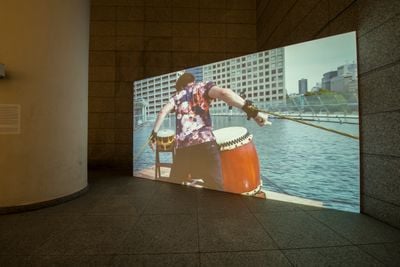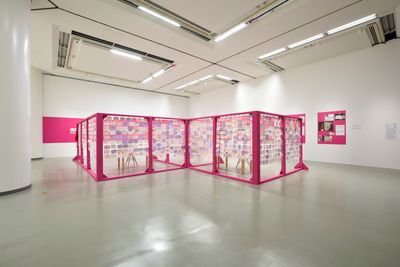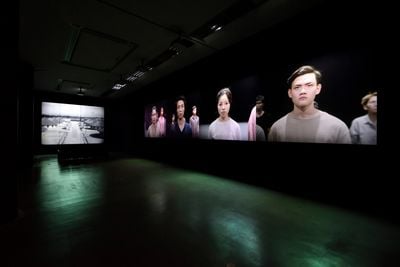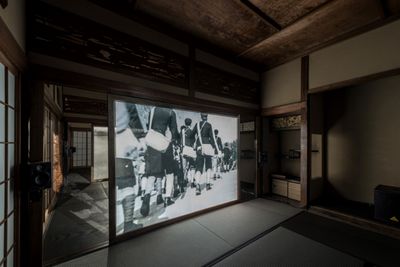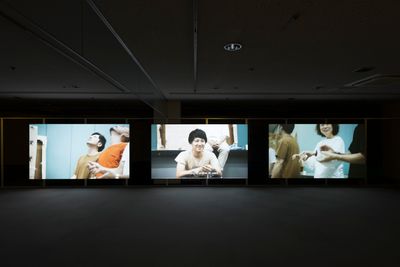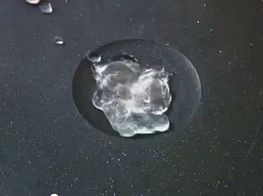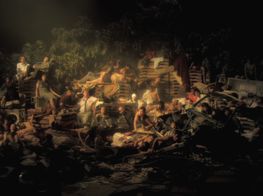Aichi Triennale Grapples with History and Censorship
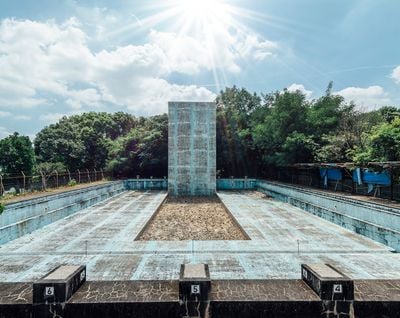
Tadasu Takamine, Anti-thesis: Gazing up at the endless blue // stained forever by its color // I have ceased to be myself (2019). Exhibition view: Taming Y/Our Passion, Aichi Triennale 2019, Aichi Prefecture (1 August–14 October 2019). Courtesy Aichi Triennale. Photo: Takeshi Hirabayashi.
The 2019 Aichi Triennale (1 August–14 October 2019) is all about mediating polarisations—whether between 'nationalism and globalism, elitism and anti-intellectualism, universalism and relativism, idealism and realism, metropole and periphery, young and old'. The exhibition enacts this mediation by deftly weaving together works employing different modes and registers of conciliation—from high to low, material to conceptual, ephemeral and monumental—across sites in Nagoya and Toyota City. At Nagoya City Art Museum, a group of Keiko Masumoto's ceramics, including a pot with the form of a pagoda cutting through its body, skilfully update traditional forms and materials, while Tadasu Takamine's outdoor installation at Toyota Municipal Museum of Art, Anti-thesis: Gazing up at the endless blue // stained forever by its color // I have ceased to be myself (2019), presents a cut slab of an old swimming pool floor raised to high sculpture.
In Nagono Station, one of the spaces used within the Shikemichi and Endoji area, where Edo Period architecture was left unscathed by World War II, Song-Ming Ang and Jason Maling's PowerPoint presentation mixes musical compositions and lo-fi graphics to create opening credits for what the title describes: Truly Existing Imaginary Genres (2018). 'Neo-Liberal Adult Contemporary' comprises gold dollar, yen, euro, and pound signs hovering over gradated millennial pink and yellow, while 'Soft Suprematist Synth Line' is replete with constructivist shapes.
In his curatorial statement, artistic director Daisuke Tsuda links rising anti-immigrant sentiments in the U.K. and U.S. since the Brexit vote and Donald Trump's election, and the recent emboldening of xenophobia in Japan. The source of such shifts, Tsuda writes, 'is anxiety—anxiety of an uncertain future, and the anxiety of feeling unsafe and vulnerable to danger.'
Fanning these anxious flames is the internet, where 'a breathtaking amount of information is transmitted for the purpose of agitating its users' into states of extreme emotion that support the validation of false information. Tsuda, a journalist and media activist, cites recent research revealing how people are more likely to continue reading websites that publish falsehoods after being confronted with their inaccuracies. He aligns these trends with 'the rise of data-centric politics aimed only at winning elections,' and the popularity of 'politicians who promote simple answers to complex social issues' rather than 'those who pursue an agreement through deliberation and negotiation'.
With civil society driven more by emotion than reason, Tsuda suggests, 'the old art (ars) of governance informed by the knowledge and skills of the humanities has grown obsolete'. Hence the title of this Triennale, which 'eschews the simplification of a grey, mosaic world into black and white': Taming Y/Our Passion. As a whole, the show brings together works by over 80 artists within a definition of art as a skill that might contribute to the taming of jō (情)—defined in the Kanji dictionary Kanjigen as 'movements in the heart that arise from sensation or emotion', using the character's two other meanings: 'true things and true appearances, information' and 'empathy and compassion'.
Encapsulating this intention succinctly, particularly when thinking about the sociopolitical observations Tsuda makes in his curatorial statement, are Tsubasa Kato's two videos showing in the basement of Aichi Arts Center, Woodstock (2017) and 2679 (2019). Musicians, their bodies bound and restricted, attempt to play the national anthem of the U.S. and Japan respectively, with each performer's struggle becoming a portrait of a push-pull tension between purpose and restraint—a tension that is mirrored in the art that this Triennale showcases.
At Aichi Arts Center, Koki Tanaka's Abstracted / Family (2019) resists what the artist describes as 'a fantasy in Japan that the Japanese are a homogenous race'. A sprawling installation of abstract paintings, video works, photographs, and other ephemera represent the experiences of four people either born in Japan or who settled here early in life. With roots in the Korean Peninsula, Bolivia, Bangladesh, and Brazil, these are identities that do not conform to a singular nationalism.
Kosuke Nagata's cooking show-cross-video essay Translation Zone (2019) similarly challenges notions of cultural purity. It does so by looking at how traditional recipes like fried rice have travelled and adapted to new contexts through various means, from migration to molecular gastronomy, and relating this to language's trajectory of circulation and mutation. As demonstrated by Walead Beshty's 'FedEx' series (2017–ongoing), a group of cracked glass boxes damaged from their time spent travelling the world in FedEx boxes, form is fragmented the more it moves.
An adroit study of the shaping of culture from the perspective of 'small history' rather than the 'big history of nations and ethnicity', Translation Zone mentions Hong Kong's extradition bill protests to diagram the peculiarities of language development in relation to an online statement expressing remorse at Hong Kong's assimilation into China. In that statement, the word 'sad' was mistranslated to 'happy' by Google Translate—not the result of a hack, the video-essay supposes, but the re-education of Google's translation engine through manipulation by a mass of users.
GE YU LU (2017) is another example of how networked tools can be used to affect or subvert real-life definitions. The installation, presented in a small space in Shikemichi and Endoji, outlines through video and archive documentation how Ge Yulu managed to name streets throughout China after himself by erecting street signs that were eventually absorbed into official infrastructures and information networks as official locations. (One such sign is installed in an empty lot outside the space.) When the project was discovered in 2017, it became national news—in one video we see an edit of numerous news anchors stating the road name again and again.
The process by which people can manipulate reality, whether coordinated or not, was echoed in the closure of a display at the Aichi Arts Center on 3 August. After 'Freedom of Expression?' was an expanded re-staging of a 2015 show at Gallery Furuto in Tokyo that included works that had been removed from public view alongside the reasons for their removal—be it references to Japan's conduct in the Second World War, its history of colonial rule in Asia, or criticism against the monarchy or government. Its closure was prompted by a well-mediated public backlash directed at Statue of Peace (2011) by Kim Seo-kyung and Kim Eun-sung—an edition of a sculpture originally placed outside the Japanese embassy in Seoul of a seated young girl. The girl represents the so-called comfort women forced into sexual slavery during World War II by the Japanese, whose occupation of Korea lasted from 1910 to 1945.
The issue of comfort women has long been a point of painful and heated contention between Japan and South Korea, with Japan only officially apologising—and thus finally acknowledging this history—in 2015. In 2017, an edition of Statue of Peace was placed in front of the Japanese embassy in Busan, prompting the recall of its ambassador. Further afield that year, Osaka Mayor Hirofumi Yoshimura vowed to terminate a 60-year sister-tie with San Francisco because the city declared a comfort woman statue—erected by California's Korean, Chinese, and Filipino communities—public property.
As reported, the Aichi Triennale became the target of intimidation, including a threat to burn down the Aichi Arts Center in a chilling echo of a recent arson attack on a Kyoto animation studio. Nagoya Mayor Takashi Kawamura effectively legitimised these threats when he demanded the removal of Statue of Peace while questioning the factual accuracy of the comfort woman issue, with other officials also voicing contempt in the public sphere. After the display's closure, Triennale artists released a collective letter decrying the act as censorship, with some removing or modifying their work in protest. Mónica Mayer's The Clothesline (2019), which involved women writing experiences of sexual harassment and abuse on cards that were hung on a series of pink frames, has since been renamed The Silent Clothesline with all answers removed.
In recent statements, Daisuke Tsuda has claimed solidarity with Triennale artists while asserting that safety concerns prompted the Triennale's decision. 'The need for such a response', Tsuda conceded, 'demonstrates . . . that Japan's current social climate does not allow for discussions about the state of our country, or about the darker aspects of its past'. The furore around Statue of Peace, which resulted in the censorship of a display about censorship, has made visible the polarised conditions that the exhibition is attempting to mediate. Tsuda's curatorial proposal to collectively (and honestly) confront history in Japan—while situating the country within a broader global context—revealed conflict, resistance, and outright refusal among its audience.
The history of comfort women connects more broadly to Japan's conduct in World War II and its colonial past, something the censorship display also confronted, as does the Aichi Triennale albeit in keeping with its resistance towards polarity through modes of empathy and embodied complexity. Bontaro Dokuyama's Time goes by (2017) shows interviews with Japanese-speaking Taiwanese elders educated in colonial Taiwan, occupied by from 1895 to 1945, some praising the education they received; while Hikaru Fujii's video installation Mujō (The Heartless) (2019), presents grainy black-and-white archive footage of 'Japanisation' drills in a civilian training centre in 1940s Taiwan on one screen, with colour footage of foreigners living in Aichi mirroring these exercises in a black-box studio on another.
Nodoka Odawara's multi-part project linking the development of public sculpture in Japan to the war and its aftermath, ↓ (1946–1948) (2011–2019), includes a neon-light sculpture referencing an arrow-shaped post that appeared in 1946 at the spot where the atomic bomb landed in Nagasaki. At the time, according to the artist's text provided on site, occupying allied forces—who were said to have censored mentions of the effects of the bomb in its aftermath—prohibited memorials on the site.
Ho Tzu Nyen's Hotel Aporia (2019), a six-channel video installation inhabiting the two floors of a former guesthouse in Toyota City known as Kirakutei, raises the ghosts of kamikaze pilots hosted by the inn during World War II, and the families who came here to mourn them. The work is composed of videos weaving digitally treated edits from old Japanese films. Faces are blurred out, shots resembling the interiors where each video is screened come into view, and layers of voices narrate letters past and present, with each montage punctuated by thunderous rumblings that physically rattle the space.
Hotel Aporia's title describes an unresolvable internal contradiction—not unlike that of a nation-state's and the violence that so often consolidates its border and identity both internally and externally. The work is a moving and earnest portrait of kamikaze soldiers as men and boys caught in a political tempest, stripping away propaganda to lament, honour, and challenge the conditions around an obedience enacted in the service of nationhood, often without choice, which characterises histories of war.
At the same time, Hotel Aporia ponders residual sentiments that lurk in the remains. One of the videos focuses on Yokoyama Ryuichi, creator of popular cartoon character Fuku-chan, who belonged to the Army's wartime propaganda unit. In a series of letters that are narrated over the imagery, we are told Fuku-chan appeared in the newspaper Asahi Shimbun following the Pearl Harbour attack shouting 'Tokkan!'—the Kamikaze battle cry. In 1944, Ryuichi published Jakarta Chronicles, introduced by Lieutenant Commander Machida Keiji as a means—'through laughter'—to celebrate Japan's claims on Indonesian territory. None of this propaganda is on view at the Yokoyama Ryuichi Memorial Manga Museum in Kochi, we learn—at the opening, though, Ryuichi declared no regrets and a willingness to serve his nation again if called upon. He never heard of anyone joining the army because of a cartoon.
Ryuichi's position contrasts with a brief mention of Miki Kiyoshi—described as a Marxist of the Kyoto School who conceived of the concept of the 'East Asia Co-Prosperity Sphere'. The reference to Kiyoshi, who was said to abhor the militarisation of his ideas and died in Japanese prison on the Philippines, operates like a foil. Both figures draw attention to the aporia of the nation-state and what it asks of—and does to—its people, let alone others, to engineer a collective identity.
The process of engineering collective identity like a nation-state within the context of the industrialised 20th century (and its wars) connects with the context in which Kirakutei is located. Formerly known as Koromo, the city was renamed in the late 1950s after the motor corporation that came here in the 1930s—an example of a place and community shaped by industry. Tapping into this reality at Toyota Citizens' Gallery is Anna Witt's three-channel video installation, Unboxing the Future (2019), which engages Toyota factory workers in candid discussion about automation and the future of labour, revealing a complex matrix of nuanced positions.
Throughout the film, participants engage in exercises that reframe systemic monotony, such as turning repetitive gestures of factory labour into meditative movements. In one conversation, a worker talks about wanting to break out of rigid frames of existence; she admits wanting to raise a hand when waiting on the train platform, knowing the action would be regarded as 'freakish' since it diverges from normal behaviour. 'If I'm not conscious of how much I'm kept inside a box,' she says, 'I'll feel like I'll be totally stuck.' It is this kind of unboxing that the Aichi Triennale attempted to facilitate: an invitation to open up that resulted in a literal closure.—[O]


